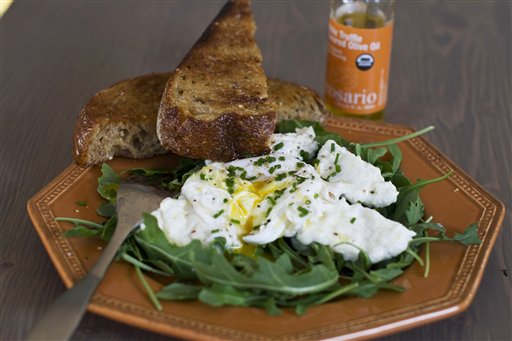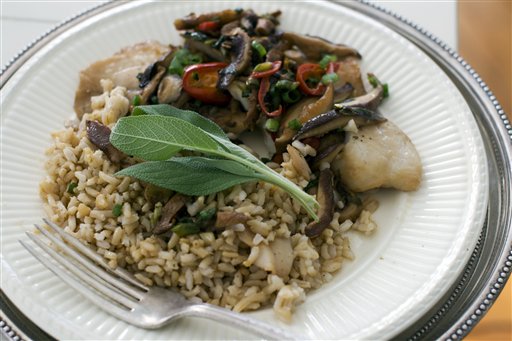

This April 25, 2011 photo shows, clockwise from top, steak with maple apple bourbon barbecue sauce, chicken with Asian style vinegar sauce and tuna steak with mango mustard barbecue sauce in Concord, N.H. (AP Photo/Matthew Mead)
Tangy or mellow, spicy or mild, barbecue sauce is the icing on the steak — or ribs, or whatever else it is you happen to throw on the grill.
And just as in real estate, location is a big deal, with new attention being paid to the various regional recipes for grilling success.
“It’s all about authenticity right now. Everybody wants to stay true to the different regions,” says Chris Lilly, vice president of the renowned Big Bob Gibson Bar-B-Q restaurants in Alabama and head of their competition team.
And the differences aren’t always subtle. This is, after all, barbecue. In Northern Alabama, for example, there’s a white barbecue sauce based on mayonnaise with black pepper and a little lemon juice. While Kansas City is home of a tangy, tomato and molasses-influenced sauces, the inspiration for the brand KC Masterpiece.
Overall, barbecue sauce sales in the U.S. reached $660 million in 2010, gaining 21 percent from 2005, according to a recent report from market research company Mintel.
And that growth likely will continue. With beef and pork prices on the increase, food trend observer Phil Lempert, the “Supermarket Guru,” expects sales of barbecue sauce to increase as people look for ways to improve the taste of cheaper cuts of meat.
But slow down before you slather it on. Lempert notes that most people don’t use barbecue sauces properly. They should be brushed onto the meat during the final minutes of cooking — not at the start — otherwise they’ll probably burn.
And if you’re aiming to make meat more tender, look for sauces that are high in acid, not sugar. “I always make my own using grapefruit, orange or tomato juices and add a few spices,” says Lempert.
For those who do know their way around the grill, competitive barbecuing continues to grow, with more competitions popping up and TV shows devoted to griller warfare.
“It’s a fantastic hobby,” says Lilly, who is also the official pitmaster for Kingsford charcoal. “Any given weekend in the U.S. you’ll have 10 to 12 different competitions where you can go to cook.”
And it’s not all lazy afternoons in the park. Competitors cook through rain and wind. Lilly once had to evacuate a park where a competition was being held due to a tornado threat. His competition meat was already on the grill, slow-cooking away so he left, came back the next morning — and won.
Sauce and marinades are one part of a successful barbecue. The other is controlling your fire.
“The biggest mistake is setting up the charcoal fire all for direct grilling,” says Lilly. The trick is to push the charcoal to one side so that you can have direct and indirect heat, controlling how quickly the food will cook.”
You also need to take advantage of the grill lid and keep it closed.
“Shut your grill, be patient, enjoy your friends and family around the charcoal grill and let the grill do what it’s supposed to do and that’s cook fantastic food,” says Lilly.
___
Online:
Lempert’s site: http://www.supermarketguru.com
Lilly: http://www.bigbobgibson.com/main.htm
___
MAPLE APPLE BOURBON BARBECUE SAUCE
This thick, tomato-based sauce is a good choice for basting on grilled meats toward the end of cooking.
Start to finish: 45 minutes
Makes: 3 cups
1 tablespoon vegetable oil
1 medium yellow onion, diced
1 clove garlic, minced
2 apples, peeled, cored and diced
1 tablespoon grated fresh ginger
1/2 cup maple syrup
1/2 cup cider vinegar
1/2 cup bourbon
1 cup chili sauce
1 teaspoon salt
1/2 teaspoon ground black pepper
1/2 teaspoon cinnamon
1/4 teaspoon cayenne
In a medium saucepan over medium-high, heat the oil. Add the onion, garlic and apple. Cook until the onions are a golden brown and the apples are quite soft, about 10 minutes.
Add all remaining ingredients, then return to a simmer. Lower the temperature to medium, cover and continue to cook, stirring often, for 30 minutes. Adjust the salt and pepper. Transfer to a blender, in batches if necessary, then puree until smooth. Cool, then refrigerate in sealed glass jars for 2 weeks.
Nutrition information per 1/4 cup serving (values are rounded to the nearest whole number): 105 calories; 11 calories from fat (10 percent of total calories); 1 g fat (0 g saturated; 0 g trans fats); 0 mg cholesterol; 19 g carbohydrate; 0 g protein; 1 g fiber; 803 mg sodium.
(Recipe from Alison Ladman)
___
ASIAN-STYLE VINEGAR SAUCE
This sauce is a great choice for tossing with shredded meats or for mopping over grilled meats as they cook. It also is good for dressing an Asian slaw.
Start to finish: 10 minutes
Makes: 1 1/2 cup
1 teaspoon canola or vegetable oil
2 tablespoons grated fresh ginger
1 clove garlic, minced
1 teaspoon five-spice powder
1/2 cup packed brown sugar
1/2 cup soy sauce
1/2 cup rice wine vinegar
2 tablespoons toasted sesame oil
In a small saucepan over medium-low, heat the oil. Add the ginger and garlic, then saute for 5 minutes. Add the five-spice powder, brown sugar, soy sauce and vinegar, then simmer for 5 minutes, or until the mixture is well combined and the sugar is dissolved. Stir in the sesame oil. Cool, then refrigerate in sealed glass jars for 2 weeks.
Nutrition information per 1/4 cup serving (values are rounded to the nearest whole number): 143 calories; 47 calories from fat (33 percent of total calories); 5 g fat (1 g saturated; 0 g trans fats); 0 mg cholesterol; 24 g carbohydrate; 2 g protein; 0 g fiber; 1021 mg sodium.
(Recipe from Alison Ladman)
___
MANGO MUSTARD BARBECUE SAUCE
This fruity and spicy sauce is equally delicious slathered on chicken or pork.
Start to finish: 45 minutes
Makes: 2 1/2 cups
1 cup yellow mustard
1 cup cider vinegar
1/2 cup honey
1 tablespoon Worcestershire sauce
1 teaspoon dried thyme
1/2 teaspoon dried oregano
1/2 teaspoon cumin
1/2 teaspoon cayenne
1/2 teaspoon salt
1/2 teaspoon ground black pepper
10-ounce package frozen mango chunks, thawed
In a medium saucepan over medium, combine all ingredients. Cook for 30 minutes, stirring frequently. Working in batches if needed, transfer the mixture to a blender and puree until smooth. Cool, then refrigerate in sealed glass jars for 2 weeks.
Nutrition information per 1/4 cup serving (values are rounded to the nearest whole number): 75 calories; 1 calories from fat (0 percent of total calories); 0 g fat (0 g saturated; 0 g trans fats); 0 mg cholesterol; 19 g carbohydrate; 0 g protein; 1 g fiber; 479 mg sodium.
(Recipe from Alison Ladman)






